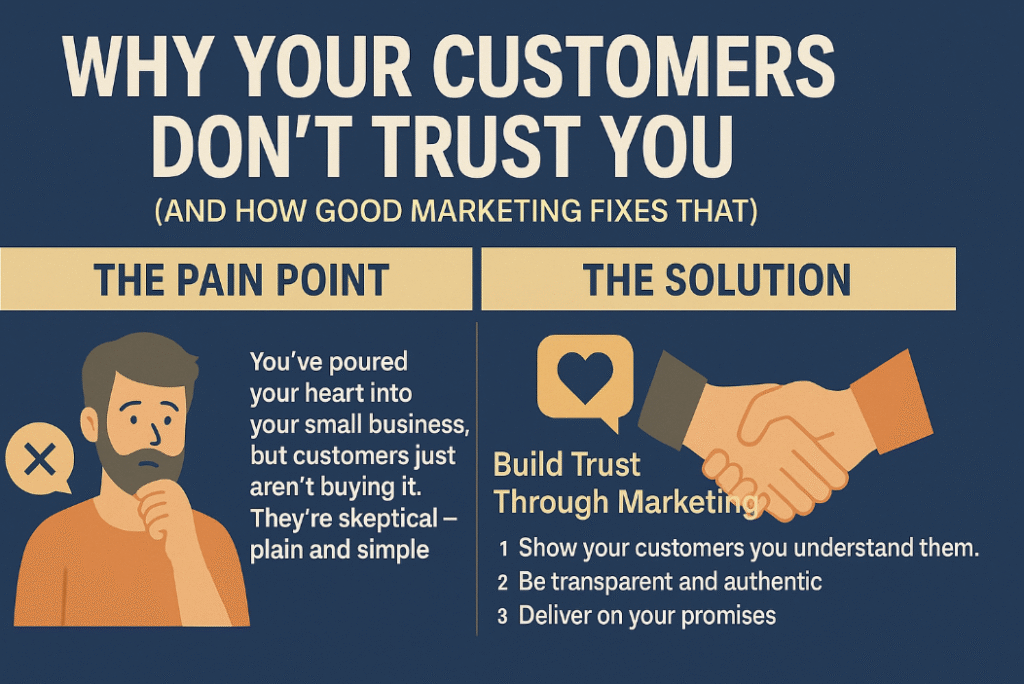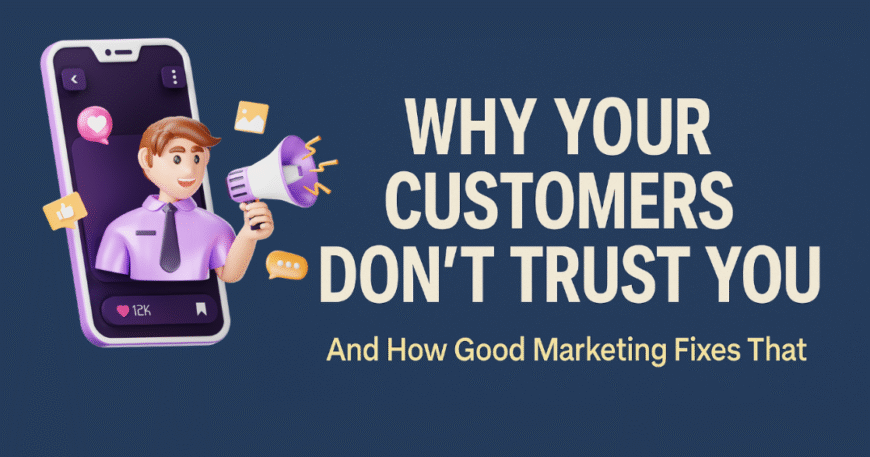Let’s Be Real: They Don’t Trust You—and It’s Not Their Fault
Look, if you’re running a small business in the US—especially in those early messy years—you’re juggling everything: making sales, chasing invoices, trying to build a brand from scratch, maybe even shipping product yourself.
You’re not sleeping. You’re worried about cash flow. You’re comparing your numbers to someone else’s highlight reel on LinkedIn and wondering if you’re already behind.
And then… crickets.
You post online, you cold email, you spend on ads—and nothing happens.
Why? Because people don’t trust you. Yet.
And here’s the uncomfortable truth:
They shouldn’t.
Not until you give them a damn good reason to.
Not until your brand stops feeling like a stranger yelling into a crowd.
Pain Point: You’re Doing the Work, But You’re Invisible
You’re doing all the things:
- Posting on Instagram.
- Writing emails.
- Throwing dollars at Facebook ads.
- Even printing flyers at Staples if you’re feeling old-school.
But none of it is landing. Because you sound like everyone else. Generic. Polished. Corporate. Like you Googled “how to write a caption” and just copy-pasted.
Meanwhile, your competitors—maybe even less qualified—are getting all the attention.
Why? Because they’ve figured something out that you haven’t:
People don’t buy the best product. They buy the one they trust.
And trust isn’t built on a fancy logo or a nice funnel.
It’s built on connection.
Let me tell you a story.

The Story: A Tale of Two Plumbers
Let’s say your water heater explodes. You Google “plumber near me.”
You find two guys:
Plumber A: Clean website. Professional logo. Vague copy:
“We pride ourselves in offering high-quality plumbing services to meet your needs.”
Plumber B: Kinda janky site, but right on the homepage is a selfie video:
“Hey, I’m Tony. I’ve been crawling under homes in this neighborhood for 17 years. I know what it’s like when your water heater goes out and your kids can’t shower before school. Here’s what I’ll do in the first 10 minutes if you call me right now…”
Guess who gets the job?
It ain’t the one with the nicest font.
It’s the one who feels real. Relatable. Trustworthy.
The Psychology: Trust is Built in Micro-Moments
We trust people who:
- Speak our language
- Acknowledge our fears
- Show their face (or voice or story)
- Seem like they’ve “been there” before us
When your message hits emotionally, people start to believe you.
When your story sounds like their story, walls come down.
This isn’t fluff—it’s biology. The human brain filters threats fast. And anything unfamiliar? Gets flagged.
That’s why slick, overproduced marketing can actually hurt you early on. It smells fake.
But when you show up like a human being with a real story?
Now they’re listening.
The Fix: Marketing That’s Rooted in Realness
Good marketing doesn’t create trust—it earns it. Here’s how to start:
1. Get Specific with Your Story
Generic = invisible. “Helping people succeed” is meaningless.
“Helping first-time gym owners get 30 leads in 30 days without spending $1 on ads”? That’s sticky.
2. Speak to Pain, Not Product
Don’t pitch what you sell. Speak to what they’re scared of.
They’re not buying a website—they’re buying the ability to look legit to investors, customers, and even their in-laws.
3. Show Your Face. Share the Mess.
People want to buy from people, not companies. Share what you’re learning.
Post the behind-the-scenes stuff. Be honest. Document the struggle. That’s what builds connection.
4. Use Testimonials That Tell Stories
Don’t just post “John loved working with us.”
Post why. “John was losing $4K/month. We fixed one landing page and he hit break-even in 3 weeks.”
Data + emotion = credibility.
5. Consistency = Familiarity = Trust
The more often people see you—saying the same thing in different ways—the safer you feel to them.
If you ghost your audience for 3 weeks and come back with a pitch, don’t be surprised when nobody buys.
Closing Thought: You Can’t Hack Trust—But You Can Build It
You don’t need better tools. You don’t need more funnels.
You need a better connection.
And that starts with understanding how your audience feels—not just what they “need.”
Good marketing doesn’t just sell.
It makes strangers believe.




